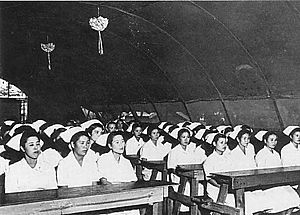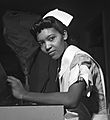Nurse education facts for kids
Nurse education is all about training people to become nurses. It teaches them the skills and knowledge they need to care for patients. This training is given to student nurses by experienced nurses and other medical experts, usually in special nursing schools.
Most countries have courses for general nursing or for special areas like mental health nursing, pediatric (children's) nursing, or caring for patients after surgery. To become a registered nurse, these courses often take about four years. There are also courses for nurses who want to learn even more about a specific area after they've qualified.
Students can get different types of qualifications, like a diploma, an associate degree, or a Bachelor of Science in nursing.
Contents
How Nursing Education Started
Long ago, nursing was mostly learned by working alongside experienced nurses, like an apprenticeship. This often happened in religious institutes, such as convents. Young women usually did this, but there have always been male nurses, especially in mental health care.
Over time, nursing education changed a lot. It moved from just practical training to including more science and research. Today, nurses learn to use research to make good decisions about patient care. This helps them become confident professionals who work as equals in the healthcare team.
In 1859, Valérie de Gasparin and her husband opened the very first nursing school in the world in Lausanne, Switzerland. Other nurses, like Ethel Gordon Fenwick, believed that nursing should be a formal profession with proper registration and taught in higher education universities, not just in hospitals.
The World Health Organization (WHO) suggested in 1955 that every country should have at least one experimental nursing school. In the UK, the first university department for nursing started in 1956 at the University of Edinburgh. In Australia, La Trobe University began the first nursing course in 1974.
Nursing in the United Kingdom
Florence Nightingale was a very important person in nursing history. In 1860, she opened the 'Nightingale Training School for Nurses' at St Thomas' Hospital in London. This school is now part of King's College London.
Her goal was to train nurses to be skilled and specialized. They learned to observe patients carefully and understand their needs. Her ideas spread, and now many British universities teach nursing.
To get into a nursing degree course in the UK, students usually need good grades in subjects like English, math, and science (especially biology) from their GCSEs and A-Levels. If you're over 21, you might get in with an "Access course" from a college and some experience in healthcare.
Nursing degrees in the UK usually take three years. Students choose a specific area to study, like adult nursing, children's nursing, mental health nursing, or learning disability nursing. The course combines classroom learning with practical experience in hospitals and other healthcare places. After graduating, new nurses must register with the Nursing and Midwifery Council to work legally.
Nursing in the United States
Before the late 1800s, nursing education in the United States was mostly hands-on training with a senior nurse in a hospital. This changed a lot over time.
- 1873: The Bellevue Hospital School of Nursing in New York City opened. It was the first US school based on Florence Nightingale's ideas.
- 1889: The University of Maryland School of Nursing (UMSON) was founded. It's one of the oldest and largest nursing schools in the US.
- 1889: The Johns Hopkins School of Nursing started. Its leaders even asked Florence Nightingale for advice on their education program.
- 1909: The University of Minnesota offered the first university-based nursing program. It was the first to give a Bachelor of Science in Nursing degree.
- 1923: The Yale School of Nursing was founded. It was the first to follow new education standards that focused on learning, not just hospital service.
- 1956: The Columbia University School of Nursing was the first to offer a master's degree in a specific nursing area.
Becoming a Nurse: Qualifications
There are different ways to become a nurse, which can sometimes be confusing.
The first nursing schools gave out diplomas, not university degrees. Later, community colleges started offering an Associate of Science in Nursing degree. Then, universities began to offer Bachelor of Science in Nursing and Bachelor of Nursing degrees. For even higher education, there are Master of Science in Nursing degrees and Doctor of Nursing Practice degrees. A Doctor of Philosophy (PhD) in Nursing is also available, but this degree focuses more on research than on direct patient care.
Nursing Degrees in Western Australia
In Western Australia (WA), you can become a nurse in two main ways:
- Registered Nurse (RN): You study at a university.
- Enrolled Nurse (EN): You study at a Technical and Further Education (TAFE) college.
Both paths have different entry requirements, like passing certain high school subjects or having prior work experience. It's always good to check with each university or TAFE for their latest requirements.
In WA, four universities offer nursing degrees:
- Edith Cowan University (ECU)
- Curtin University
- Murdoch University
- University of Notre Dame
These universities offer a Bachelor of Science (Nursing) or Bachelor of Nursing degree, which usually takes three years full-time. Once you graduate, you become a fully qualified RN with many job options.
If university isn't for you, TAFE offers a Diploma of Nursing (Enrolled-Division 2 Nursing). This diploma usually takes about 18 months full-time. After completing it, you become an EN.
Both RNs and ENs must register with the Nursing and Midwifery Board of Australia to practice legally. RNs generally have higher qualifications than ENs.
What You Learn in US Nursing Programs
Before starting a nursing program, you often need to take basic courses like math, English, biology, and anatomy. Some schools have time limits on how old these courses can be.
The main nursing courses cover subjects like anatomy (how the body is built), physiology (how the body works), pathology (diseases), and pharmacology (medicines). You'll also learn many practical skills, such as how to insert IVs, change dressings, give medications safely, and do physical exams. Learning to have a caring bedside manner is also very important.
After learning basic skills, students rotate through different hospital units like:
- Obstetrics (caring for pregnant people and new babies)
- Mental Health
- Medical and Surgical units
- Oncology (cancer care)
- Critical Care (very sick patients)
- Pediatric (children's) units
This gives students a full picture of what nursing involves. Many nursing students also use special medical software to help them study and train.
Some schools offer "accelerated" bachelor's degree programs for students who already have a degree in another field. These programs let students finish their nursing degree faster, often in 12 to 24 months. Traditional BSN programs might take 5 to 6 years, including all the required courses.
To get into many nursing programs, you often need a good GPA (grade point average), like 3.0 or higher. Some top schools require even higher grades. Many programs also use the TEAS-V test to check if students are ready for nursing school.
After graduating from a nursing program in the United States, students take one of the NCLEX exams:
- The NCLEX-PN for Licensed Practical Nurses (LPNs)
- The NCLEX-RN for Registered Nurses (RNs)
Passing this exam is required to get your nursing license.
Learning After Graduation
After a nursing student becomes a Registered Nurse, they usually need to keep learning throughout their career. This is called "continuing education" and is often required to keep their nursing license. This helps nurses stay updated with the latest medical knowledge and practices.
What Nurses Learn to Do
Nursing education teaches students many important things, including:
- Assessing patients (checking their health)
- Diagnosing nursing problems (identifying patient needs)
- Planning patient care
In the US, nursing students learn in classrooms and labs. They also do "clinical rotations" in hospitals and use "simulation" (practice with realistic models or actors) to develop their care planning and thinking skills.
Nursing Specialties
Nurses can choose to specialize in many different areas. They might even get qualified in several specialties during their career. The four main types of nursing are: Adult nursing, Children's Nursing, Mental Health Nursing, and Learning Disability Nursing.
Here are some other nursing specialty fields:
- Addiction Nurse
- Burn Care Nurse
- Cardiology (heart) Nurse
- Clinical Nurse
- Community Health Nurse
- Continence Nurse
- Diabetes Education Nurse
- District Nurse
- Dialysis Nurse
- Education
- Emergency Nurse
- Family Health Nurse
- Fertility Nurse
- Gerontology (aged care) Nurse
- Infection control
- Intensive Care
- Management
- Medical Nurse
- Mental Health Nurse
- Midwife
- Neonatal Intensive Care Nurse
- Nurse Educator
- Nurse Manager
- Nurse Practitioner
- Occupational Health Nurse
- Oncology Nurse
- Paediatric Nurse
- Peri-operative Nurse
- Plastic Surgery Nurse
- Practice Nurse (Medical Clinic)
- Rehabilitation Nurse
- Remote Area Nurse
- Research
- Rural Nurse
- School Nurse
- Surgical Nurse
- Wound Management
Goals of Nursing Education Today
Nurse educators want to make sure future nurses have a good balance of practical skills and a broader understanding of healthcare. The goal is to create nurses who are "lifelong learners." This means they can always adapt to new ideas and changes in nursing.
Hands-on learning and medical simulation are very common in nursing schools. Students practice skills like giving medications and caring for specific patients. This helps them improve their skills and learn to work well in a team.
Even though nurses spend a lot of time practicing, they also learn in classrooms. They take science courses and specific courses, like how to care for patients with addiction. Newer nursing programs also teach future nurses about patient and workforce diversity. This helps nurses understand and treat all kinds of patients, and work well with diverse colleagues.
Images for kids
-
Czech nursing students 2006.
-
The American student nurse Miss Lydia Monroe of Ringgold, Louisiana, in 1942.
Degrees You Can Get
- Practical Nursing Certificate
- Diploma in Nursing
- Associate of Science in Nursing
- Bachelor of Science in Nursing
- Master of Science in Nursing
- Doctor of Nursing Practice
- Doctor of Philosophy in Nursing (PhD)





